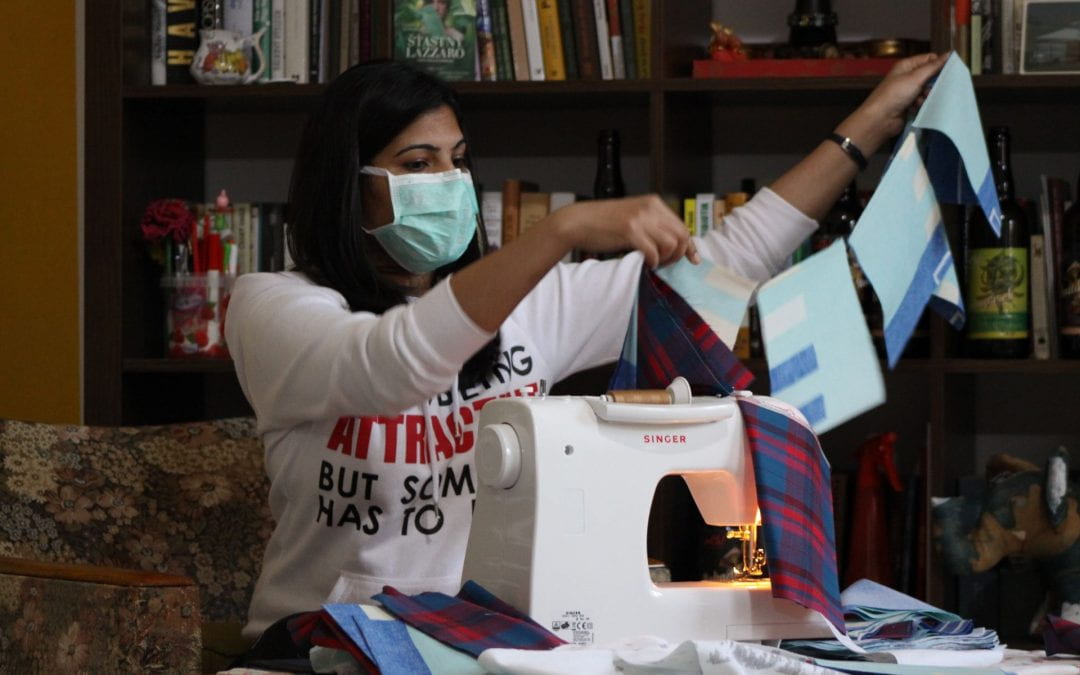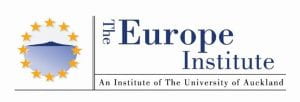By Susanna Trnka
On March 18, 2020, the Czech Republic became the first country in Europe to legislate mandatory coverage of the mouth and nose in all public areas in an attempt to mitigate the spread of COVID-19.
On March 18, 2020, the Czech Republic became the first country in Europe to legislate mandatory coverage of the mouth and nose in all public areas in an attempt to mitigate the spread of COVID-19. One could no longer walk down the street, use public transport, enter shops or pharmacies, go to school, or pass through communal areas of shared housing (such as elevators in apartment blocks), without covering their face with a scarf or face mask. Residents were given under 48 hours (i.e. until midnight March 19) to comply with the new legislation. But how could they do so when face masks were already in short supply?
In the days leading up to the announcement, there had been a popular upsurge in mask use. Surgical face masks were donned by politicians and public figures, including the Prime Minister, during press conferences, on TV, and in Parliament. Social media influencers, such as Czech entrepreneur Petr Ludwig, urged that everyone should be wearing masks, under the motto “masks for all”. Prior to the nationwide ruling, facial covering was already mandatory in some Czech towns and municipalities.
Given, however, that many shops were already sold out of masks, the government mandate threatened to plunge the country into confusion. Notably, those caught mask-less faced not only social opprobrium but stiff legal measures; as one media outlet warned, “the Czech prime minister pointed out that the deliberate spread of coronavirus is considered a crime with the sentence of up to 12 years in prison. If the police officers see someone without protective equipment on the face, they can order the person to leave the area or impose a fine of up to 10,000 korunas (€362)”
The face mask law, which was (with some exceptions) largely rescinded on March 25, 2020, was part of a broad array of legislation promoting an aggressive stance against the spread of COVID-19. The first cases of COVID-19 were reported in the Czech Republic on March 1, 2020. Twelve days later, the government declared the first nationwide state of emergency in modern history. Schools and many businesses were closed, and within a few days the international border was sealed off with all non-residents denied entry as of March 16. As of this writing over three months later (June 4, 2020), with 9,438 cases and 324 deaths, the nation has suffered comparatively lower rates of COVID-19 than neighbouring Germany and Austria.
Face masks formed a pivotal part of the government’s containment strategy (Babiš 2020). But while the government was more than happy to mandate their use, it was roundly criticised for doing so without actually ensuring the availability of sufficient numbers of masks to keep everyone covered. Despite this, uptake of the new legislation was a resounding success as there was a near instant mobilisation of face mask production. While some of this activity was spearheaded by small businesses, societies, and clubs (for example, fashion students at Prague’s Academy of Art, Architecture and Design who sewed face masks for a nearby maternity hospital), it was largely undertaken by individual women who swung into action across the nation.
Women young and old pulled out their sewing machines and transformed their living rooms and bedrooms into sites of domestic production. Over 43,000 people, mainly women, joined the “Česko sews facemasks” (“Česko šije roušky”) Facebook group where they shared patterns, advice on mask sanitisation, and tips on how to revitalise dusty sewing machines. A subtab of over 2,000 entries is devoted to detailing individual producers’ craftsmanship, sharing pictures of their productions or videos of themselves sewing in action.
While production was not limited to women, it was largely a female endeavour, often portrayed as aligned with traditional gendered divisions of labour. Having now spent several days scrolling through posts on this and similar Facebook pages, all of the ones I read, bar one, were from women, some of whom appear to be sewing cloth masks in the hundreds. According to Czech anthropologist Dr. Petra Ezzeddine, women from ethnic minority groups, including members of Roma, Vietnamese, Muslim, and refugee communities, took a particularly prominent role, with local coverage highlighting their contributions to the nationwide campaign. Photographer Antonio Cossa (whose images are reproduced here) has produced a stunning visual montage of women’s efforts, documenting the intensity of their labour.
The “Česko sews facemasks” Facebook page acted as a clearance centre with posts from those who had more material than they could use, from sewers who offered to give away masks they made, and from those in need of facial coverings. Another website – Damerousky.cz (literally: “we will give face masks”) – was set up with an interactive map enabling those who need masks to quickly locate distribution sites.
“Need” has multiple definitions. The initial drive was to have some sort of nose and mouth covering; while masks were being hurriedly made and distributed, there was also the proliferation of instructions (in both Czech and English) on how to produce your own “emergency face mask” out of a handkerchief and rubber bands or using an old t-shirt. For example, targeting English-speaking expats, Damerousky.cz offered detailed instructions on the “No-sewing T-shirt style mask,” explaining, “You need a cotton shirt that you are not sorry to lose and some scissors. See the video tutorial, no need to understand Czech.”
But quickly, there were moves to not only diversify but upscale. Amidst the sea of plain white or light blue surgical-style masks often worn by state officials, there appeared masks of contrasting colours or paisley patterns. Face masks were transformed into creative emblems as men, women, and children donned camouflage masks, bright yellow masks decorated with black ribbons, masks emblazoned with images of fire trucks or Minecraft constructions, masks made to match cloth handbags. Within a few weeks of its launch, the Facebook site was inundated with requests for specific styles or themes (e.g. “does anyone have masks decorated with white terrier dogs?”).
Trade in face masks was largely non-monetary, conducted on an as-needed basis. It was underpinned by social values that stress collective care and reciprocal responsibility (which are sometimes, particularly among older generations, articulated through the concept of solidarity (solidarnost), as promoted during the socialist era. Spurred in part by wariness of the state’s abilities (to provide masks, which were in short supply), members of the general public took on this task by providing for one another. The emphasis on collective care, moreover, shaped not only the wide-scale production and free distribution of face masks but the very rationale behind their use.
Czech public health messages clearly delineated that wearing a mask enables one to protect others as the first step in an act of reciprocal care. A Public Service Announcement distributed by Czech entrepreneur and social influencer Petr Ludwig on YouTube, and endorsed by officials in the Czech government, evokes the #Masks4All motto: “I protect you, you protect me” (“Czech PSA” 2020). Foregrounding statements by Czech scientists, the video was filmed in English in order to make internationally accessible its call to other countries to follow the Czech example of mandating face masks. Its message received the highest level of government endorsement when a link to the video was tweeted by Prime Minister Andrej Babiš as part of a pointed jab at President Donald Trump. Exhorting Trump to take heed of the Czech approach to COVID-19, Babiš’s tweet declared: “Mr. President @realDonaldTrump, try tackling virus the Czech way. Wearing a simple cloth mask, decreases the spread of the virus by 80 %!”.
While masks have historically often been used to hide one’s identity (i.e. the masked robber) or shield oneself (e.g. wearing a scarf to protect oneself from the cold), face masks have now been turned into a marker of collective care, signifying one’s effort to protect others who will, in turn, endeavour to protect them and thus together protect the nation. These sorts of efforts may come more easily to a nation familiar with conceptualising health as a public good.
When it comes specifically to respiratory health, the Czech Republic has spent decades emphasising the need for collective, and in particular, government-directed action to mitigate respiratory distress, as I have documented elsewhere. While responding to a global pandemic is different from trying to mitigate asthma, the sense of health, including respiratory health, as a collective problem in need of widespread, ideally state-led but also publicly-engaged solutions, is arguably much more embedded in the disease imaginary in the Czech Republic than it is in places such as the United States.
Face masks have also made frequent, and often dramatic, appearances on the political stage, particularly during public confrontations over the government’s responsibilities to ensure air quality. In recent years, Czech media stories have repeatedly covered whether or not running or exercising in surgical masks will protect against inhaling toxins (often suggesting that they will not). Czech environmentalist calls for collective action to support protecting respiratory health have involved their own set of facial coverings with activists eager to dramatically evoke the dangers of air pollution often donning rubber gas masks reminiscent of WWII. In such contexts, the face mask is not only protective but confrontational, highlighting both an escalating threat as well as state neglect. In doing so, it also, however, implicitly asserts the need for collective action, for a cooperative engagement between the State and its citizenry, perhaps not so different to the one currently being enacted in response to COVID-19.
As the Czech Republic eases its way out of lockdown, face masks – with or without white terriers – are less in demand. Since early April, masks have not been required in parks or outdoor nature areas, and in early May they disappeared from many school classrooms. As of May 25, masks are no longer mandatory in all public spaces, though they are still required on public transport and in in-door facilities that cannot guarantee two metre social distancing. Immortalised on Facebook, in print and online media, and in family photo collections, they may well remain a reminder of how a nation of sewers creatively rose to the challenge to keep its citizens covered, collectively endeavouring to contain COVID-19.
For more information on COVID-19, head to the Ministry of Health website.
Susanna Trnka is an Associate Professor of Anthropology at the University of Auckland and a member of the Europe Institute.
This article is published as part of a series commissioned by the Europe Institute at the University of Auckland.
For more on the Europe Institute, click here.
Photo credit Antonio Cossa.
Disclaimer: The ideas expressed in this article reflect the author’s views and not necessarily the views of The Big Q.
You might also like:
What does it mean to be responsible? 🔊
What is the role of psychological first aid in times of crisis? 🔊


